
Jeff Tweedy mentioned this Dolly Parton philosophy in his memoir, Let’s Go (So We Can Come Back):
Dolly Parton once said that her advice to anyone wanting to be an artist was to “Find out who you are and then be that on purpose.” Or something like that. As I’ve gotten older, those are the people I find myself drawn to work with and stay close to. People who have figured out who they are and are good at being that on purpose.”
Collage, the way I do it in my notebook, is the art of making connections between two seemingly unrelated things lying around. It’s a physical manifestation of the way I think. I made this one while listening to an interview with Cal Newport, who’s out there promoting his new one, Digital Minimalism.
Newport was talking about a definition of solitude he borrowed from the book Lead Yourself First: Solitude is “freedom from inputs from other minds.” (That’s not exactly how they put it in the book, but I like the word “freedom.”) According to the authors, Kethledge and Erwin, solitude is a “state of mind,” a spiritual condition, not necessarily a physical one. Here’s how Newport explains it in Digital Minimalism:
Many people mistakenly associate [solitude] with physical separation—requiring, perhaps, that you hike to a remote cabin miles from another human being. This flawed definition introduces a standard of isolation that can be impractical for most to satisfy on any sort of regular basis. As Kethledge and Erwin explain, however, solitude is about what’s happening in your brain, not the environment around you. Accordingly, they define it to be a subjective state in which your mind is free from input from other minds.
So, under this definition, you can find solitude in a busy train car or a coffee shop, or wherever. I am slightly nervous about this re-definition (it seems to me that being truly alone has a ton of value), but I am also attracted to this idea that you don’t necessarily have to be alone to be with your thoughts, you just have to be free from input.
Pete Shotton, a long-time friend of John Lennon, once talked about how Lennon couldn’t bear to be left completely alone — he always wanted someone around, even while he was writing. He’d always have the TV on or a friend around. But they didn’t need to be interacting, really. Lennon just wanted to feel another body in the room.
I’m like this. I like to have somebody else around when I’m working. I especially like it when my six-year-old comes around and we “parallel play” — we work on our own things, across the studio from one another. (I also like to have other people in the room in the form of a book. When I’m stumped when writing, I pick up one of them and start reading.)
On the other hand, I’ve been experimenting with very ways of courting old-fashioned all-by-my-lonesome solitude in my own life. Meditating by the lake. Going for long walks without headphones. I’m not sure they’re valuable to me as productivity measures. How they’re valuable can’t necessarily be measured with any kind of output or progress. These practices don’t help me be with my thoughts, they help me get rid of them. They help me empty out, drain the anxiety and rage out of my head. (Demons hate fresh air.) They let me be in my body. Without thought.
If I want to have some thoughts or do something with them, I’ll head over to my bliss station.
Thinking, after all, is not just about pushing ideas around in your head. Writing and collage are ways of thinking by pushing ideas around on the page.
Sometimes I don’t even think I can think without seeing it on the page.
And sometimes I don’t know who I am until I’m down on the page.
Oh, there I am.
